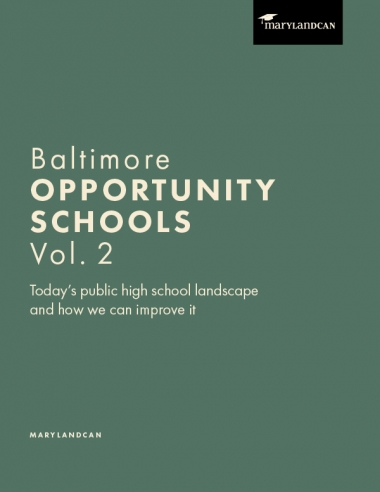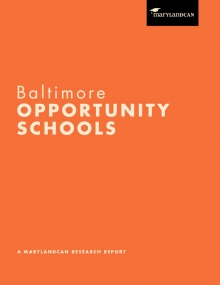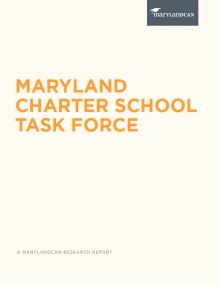Even before we finished our Baltimore Opportunity Schools report last May, we knew we needed to do a follow-up report on high schools. Our data showed that no non-entrance criteria public high schools in Baltimore were leading children from low-income households to performance levels comparable to our state averages on the Maryland High School Assessments. Those data have not changed. Events from 2015 have made the need for this report even more clear and urgent.
On a cool, clear afternoon in April, much of the city of Baltimore erupted into looting, property destruction, and confrontations with police that had not occurred here in decades. Freddie Gray’s death in police custody catapulted the city into an unrest—also known as the “Baltimore Uprising”—that gripped the nation. The first acts of property destruction, committed by high school students, were a cry for help from children whose needs had been deplorably neglected for far too long. Comments made to the media during the unrest made it clear that Gray’s death was the latest manifestation of deep systemic problems in the city including, and perhaps especially, the lack of economic opportunity in many communities.
A lack of these types of opportunities in communities has many causes including, but not limited to, a lack of high-quality education. Economic opportunity requires the implementation of successful policies in multiple areas. Effective education policy is among them. When children are not educated to create or capitalize on economic opportunity, there are few ways for a community to improve its economic prospects. Reports like this one can often seem far-removed from the day-to-day challenges that advocates and policymakers work to remedy. But the events in Baltimore this past spring serve as an acute reminder that current policies, including education policies, leave many Baltimoreans woefully underserved, without opportunities to improve their economic situations, and in desperate need of leaders who will create policy for their educational and communal well-being.
Our primary concern at MarylandCAN is to increase the number of high-quality public school seats for children from low-income households. But we are also extremely concerned about the city of Baltimore as a whole. If Baltimore—or any city or town—is to have a future of prosperity, safety, and equality of opportunity, it has to provide its children high school education that prepares them for a future that includes postsecondary education, careers that will earn them livable wages, and the capacity to take good care of themselves and their families. We believe this report will help Baltimore progress toward that goal.
We began by taking a deeper dive into Baltimore public high school outcomes. Our previous study told us that not one non-entrance criteria public high school was leading students from low-income households to outperform the state average on either the Algebra or English High School Assessment. But were those same schools leading students from low-income households to perform at high levels on other metrics? And what about similar kids at our entrance-criteria public high schools? They have generally outperformed state averages. What about similar results on other metrics? In the first part of this report, we provide what we think is the most comprehensive publication of Baltimore City public high school data in at least a decade. This is what the data tell us:
In general, Baltimore non-entrance criteria public high schools are not leading students from low-income households to achieve at acceptable levels on any metrics.
In general, students from low-income households at our entrance criteria public high schools are performing at higher levels than their counterparts at non-entrance criteria high schools on all metrics, but:
their performance is still not comparable to the performance of students from higher-income households, and
when it comes to certain HSA proficiency rates, graduation rates and college persistence over the last several years, low-income students from the following non-entrance criteria high schools have at times out-performed their counterparts at Paul Laurence Dunbar High School and Baltimore City College, which are entrance-criteria high schools.
The data clearly show that Baltimore’s children from low-income households do not have access to public high school education that adequately prepares them for postsecondary education or careers; even those who matriculate to entrance-criteria high schools do not always perform at a level comparable to children from higher-income households or even as well as their peers at non-entrance criteria high schools. Given this reality, we were left with the question, are there any non-entrance criteria public high schools in the United States that are serving these populations better? We were relieved and encouraged to find that there are.
We talked to leaders at these schools to identify school practices and the policies that enable them that could be implemented in Baltimore. It is our hope that we can work with policymakers and other stakeholders in implementing these policies and practices. Together, we can help Baltimore students begin to break the persistent link between poverty and low high school achievement.


